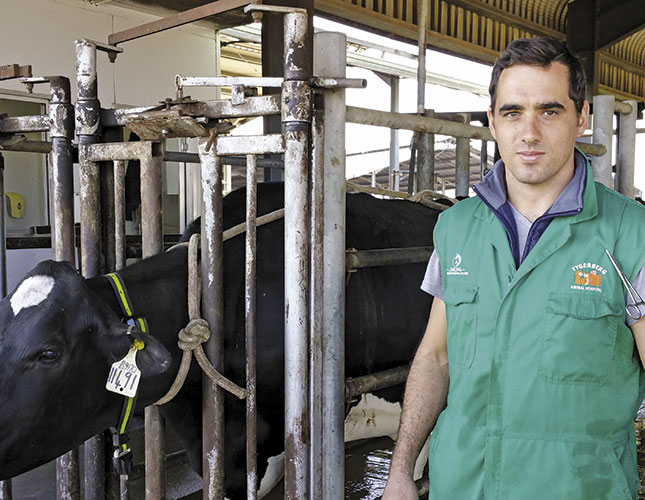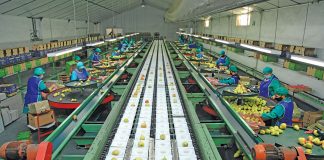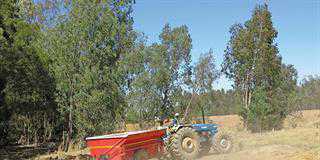
Photo: Supplied
How has the role of veterinarians changed since you qualified?
In the six years since I’ve been practising, there has been a definite shift in the role of vets. Rising production costs have resulted in farmers carrying out diagnosis and treatment themselves rather than consulting a vet. Vets are only called out for traditional diagnostic purposes when a high-value animal is at stake. As a result, vets do more contract work for large farms where the size of the operation justifies the cost.
There is also more emphasis on disease prevention and the optimal functioning of animals. On a dairy farm, for example, a vet would assist a farmer to devise a health-risk strategy based on associated risks on the farm and in the region. Health and production data are used to identify threats before they turn into conditions that negatively affect production.
What information must a farmer provide when they call about a sick animal?
The full history, onset and symptoms, whether these changed over time, and how many animals are affected. Did the farmer get advice from anyone else? What medications are being used?
What is technology’s future in farm animal health?
Farmers have become more sophisticated in the technology they use to monitor and keep records of animal health and production. This is especially true in feedlots and large poultry, pig and dairy farms. It has resulted in a severe data overload, and in doing so has created new opportunities for people outside farming to add value to production by interpreting this data. Recommendations can be made based on production trends, that can help farmers reduce costs and improve output.
An example of useful new technology is the new ruminant monitors for dairy cows that are attached to the ear or around the neck. A dip in rumination indicates that something is wrong with a cow, and research has shown that these monitors can pick up problems up to two days before there is a drop in milk production. They thus allows farmers to take action before the problem becomes so serious that it requires the use of antibiotics, for example.
How serious is antimicrobial resistance in the livestock industry?
Antimicrobial reistance is a major problem, but it’s difficult to quantify as it requires testing, and is difficult to monitor when large groups of animals are treated. Over the past season, RuVasa has seen an increase in the number of resistance reports of other veterinary medicines, such as the anthelmintic groups used for nematodes.
Countries are implementing different strategies to address the issue. The New Zealanders, for example, are using anti-inflammatories rather than antibiotics. In the Netherlands, antibiotics can now only be administered by a vet, which has greatly increased costs. Because of this, usage has decreased.
How can antimicrobial resistance be prevented?
Resistance is inevitable in the long run, so farmers want available products to last as long as possible. This means, firstly, using these medicines only when necessary, not merely for preventative reasons. Many farmers use a shotgun approach when treating diseases, resulting in under- or over-treatment. This is not good enough – conduct tests to confirm that the treatment is working.
Secondly, use the products at the right dosage and correctly. Keep them at the optimal temperature, mix them properly and apply them correctly. Thirdly, don’t chop and change products. Lastly, keep records and be aware of what is happening in your herd. If a specific product is no longer working on your farm, carry out a test to confirm whether or not this is due to resistance. Remember: it is the pathogens that become resistant to the product, not the livestock.
What is the greatest disease threat right now?
The bacterial disease brucellosis (Brucella abortus), which causes abortions and small full-term calves. Infected cows might suffer from retained afterbirth, difficulty in conceiving or infertility. The disease usually spreads when the aborted calf, afterbirth or vaginal discharge of an infected animal is licked or eaten by another animal.
Humans can get undulant fever from handling these infected items, or when drinking unpasteurised milk containing the bacteria. Symptoms in humans include fever, excessive sweating, weakness, muscle pain, headache and malaise. The disease can last from several days to eight weeks, or become chronic.
Why has it become such a threat?
The past decade has seen a great increase in the number of animals traded across the country, resulting in new diseases being brought onto farms. In the Western Cape, we are fortunate that testing is performed regularly and state vet services are doing a good job in managing the disease. Beginning this winter, our vet group will roll out a regular testing campaign in beef herds in the areas we service. By law, dairy cattle have to be tested regularly.
Whose responsibility is it to prevent brucellosis?
The industry must realise that government has set clear protocols on how to prevent and manage disease outbreaks, but we cannot expect it to do everything for us. Farmers and feedlots must be vigilant. Before buying in new animals, farmers must have them tested for infectious diseases.
Even then, these animals must be kept in quarantine for up to four weeks to make sure they have no contagious diseases. Auction houses also have a responsibility, as many animals from different areas are exposed to each other at the sales, resulting in an increased risk of disease contamination and spread.
Vets have to inform the state when an animal tests positive for brucellosis. Once an outbreak has occurred, it takes up to two years to rid a farm of the disease – if treated properly. Animals must be tested and retested until all those that test positive have been slaughtered. This may seem tedious and costly, but it’s much less costly than not testing and having the disease spread.
So, it boils down to good biosecurity?
Yes. There are many diseases that can be prevented by having a good biosecurity plan on a farm. This should take into account fencing, the introduction of new animals and access control. For example, diseases can be spread via vehicles, speculators and vets. The red meat and dairy industries could learn a lot about biosecurity from the pork and poultry industries.
I recently attended a conference where a British presenter spoke about the way in which digital dermatitis spread across the UK. The first case of the disease was reported about 15 years ago, and since then it has spread across the country. The pathogen has been shown to survive on metal and it has been hypothesised that knives used by hoof trimmers might have contributed to the spread of the disease.
What do you think of government’s draft veterinary strategy?
The Department of Agriculture, Forestry and Fisheries has held public consultation workshops countrywide to discuss new issues affecting animal and public health. The outcome is a draft veterinary strategy with clear goals to minimise these risks and improve international trade.
The strategy has clear and realistic target periods for interventions, which is positive. There is also room for more collaboration between private and state vets, which might help to reduce duplication and create new opportunities for us.
Email Dr Gordon Adam at [email protected]












